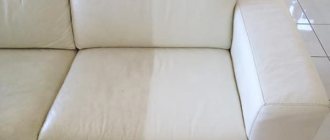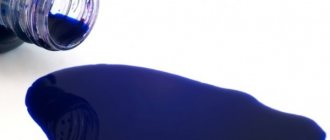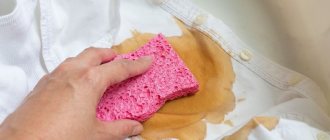Getting ink from a pen onto leather clothes or a sofa is a real problem, because the paste is extremely difficult to wipe off from any surface.
Unlike fabric (natural and synthetic), leather cannot be subjected to aggressive washing. It reacts to many solvents by the appearance of faded spots.
Before you wipe the handle off a leather product, you need to find out the possible damage and the removal technology.
Features of removing pens from natural and synthetic leather
If your leather gets dirty, you don’t need to go to the dry cleaner right away. You can often remove it yourself using store-bought cleaning products.
It is important to begin removing the stain as soon as it appears. Old paste is much more difficult to scrub off. Over time, the ink is absorbed and it will be almost impossible to wipe it off.
Before any cleaning procedures, you must adhere to the following rules:
- Do not immediately clean the main surface. It is better to try it on an inconspicuous area. If the method damages the skin, it is better to try other methods.
- Do not immediately start aggressive cleaning, for example, with organic solvents. It’s better to try more gentle methods, and then go for a promotion.
- Even the leather on your sofa can begin to dry out and crack. This comes from dehydration and can be further nourished. After washing, it is better to go over the damaged areas with glycerin syrup or castor oil. They will nourish the skin and it will shine.
- The product should dry only at room temperature. The use of a hair dryer (especially an industrial one) is strictly prohibited. This will cause cracking and drying out.
- Almost all stain removers damage the skin. Therefore, it is imperative not to deviate from the instructions and comply with its standards.
In addition, regular ballpoint pens are much more difficult to clean off. They contain oil that prevents the pigment from being removed. Gel and feather pastes are easier to remove.
Leatherette
Everyone has a leather substitute in their home. Its composition requires more careful handling, since any mechanical damage can lead to its peeling. The surface layer will begin to separate and the product will be damaged.
Under no circumstances should you use:
- Alkaline, acid and chlorine preparations. These are good solvents for some materials, but they are very damaging to leatherettes.
- Nefras. A petroleum solvent, such as white spirit, interacts with plastic types of leather substitute, dissolving them.
- Industrial, mineral, synthetic and semi-synthetic oils.
- Turpentine. This wood resin solvent has the property of dissolving polyvinyl chloride, polyacetate and polyurethane.
- Bleaches. Together with the paste, they will also remove a layer of paint from the surface of the substitute.
- Abrasives. Mechanical damage to leatherette is contraindicated, as it immediately bursts and can no longer be used.
Genuine Leather
All restrictions that are also present in artificial leather apply to natural leather. But you should follow a few additional rules:
- Natural leather should not be wetted. It is advisable not to use a wet cloth to wipe off solvent or stain remover. This may result in bubbles and uneven tone. It is best to use a slightly damp cloth or special wipes for caring for leather clothing and products.
- Cleansing with Vaseline and Glycerin. After cleaning has been done, you need to wipe the area with Vaseline oil or glycerin syrup. This will get rid of drying out and cracks.
Anti-Soviet
Eco-leather is not as durable as natural leather, so trying to remove a stain can lead to discoloration of the material or even the formation of a hole.
To prevent this from happening, you cannot:
- Rub the leatherette with great effort.
- Try to scrape off the ink paste with your fingernail or scraper.
- Use aggressive substances such as solvent.
Be sure to test before using stain remover.
You will find proven methods and means for removing marks from gel and ballpoint pens in this section.
How to remove a fresh pen mark from leatherette
The easiest way to remove a fresh stain that has just formed. Older stains are much more easily absorbed and will require formulations with better penetration.
When using the methods listed below, you must strictly follow the instructions. Otherwise, there is a possibility of permanent damage to the surface and a faded stain will appear. All that remains is to paint it over using shoe compounds.
- Soap. You need to use regular laundry soap. This method has a big drawback - it is likely to damage the surface. The composition contains caustic soda (sodium hydroxide), which is an alkali. Despite its small amount, it can damage leather upholstery. Rub a little soap into a small amount of water. After this, you need to carefully wipe the contaminated surface with a rag until the ink is completely removed.
- Dishwashing liquid. This method is best suited for ballpoint pens. The pigment in the composition is bound with oils, which form a durable film. The oil needs to be broken down and a detergent is suitable for this. You need to take the most gentle liquid that is not prone to corroding the surface. The composition is rubbed into the skin using circular movements. Do not do this for a long time and after washing, immediately rinse with Vaseline or glycerin.
- Fine salt. In the store you need to buy “Extra salt”, which is much smaller compared to regular table salt. It is mixed with water in a ratio of 1 to 10. The mixture is applied to the surface. After this, you need to wait until it dries and rinse off.
We scrub clothes, bags, clutches, wallets, backpacks
Do not use solvents on clothing or other everyday items prematurely.
If the manufacturer's label allows washing, this should be done with regular detergent. For a better effect, you can temporarily soak the dirty area in a weak solution of citric acid, and then the handle will be much easier to remove from the synthetic leather.
Note: Linoleum and painted surfaces can be cleaned in the same natural way.
How to remove an old or large ink stain
If the pen leaked or the stain was not immediately noticed, you will have to try hard to wipe it off. You can remove a stain from a leather sofa or clothing, but this requires the use of special products.
In addition to ready-made stain removers, you can use special formulations that you mix yourself. Most of them are in everyone's pantry at home, so you don't even have to go to the store.
Alcohol based products
It is not recommended to use liquids containing alcohol, as they have the ability to bind and remove liquid. This will lead to:
- Aging. The skin tightens, ages and becomes less attractive. This is especially evident on white products.
- Causes cracks. The main disadvantage of alcohol is that it can be very dehydrating to the skin. Before scrubbing a handle from a leather sofa or chair, it is advisable to check in a small area whether the surface will be damaged.
The following liquids are mainly used:
- Pure ethyl alcohol. It is best to dilute it with water, as it is most harmful to the skin. They moisten a swab with it and pass it over the surface with ink. After this, you need to use glycerin.
- Vodka. Ready-made composition that does not require additional dilution. Its influence is much more gentle.
- Alcohol face lotion. They contain a small amount of ethanol, so they are best suited for wiping delicate surfaces.
Ammonia will also work. It has an extremely negative effect on the skin. Its use is especially noticeable on white and beige backgrounds. It should be mixed in a proportion of 1 tablespoon per 250 grams of water. After this, the composition is rubbed into the ink with a swab. It erases paste best, but causes just as much damage.
Stain removers and solvents
How to wipe a handle off leatherette and genuine leather if alcohol doesn’t help? In this case, you can use store-bought solvents and stain removers that are designed specifically for working with delicate surfaces.
Industrial solvents should be used only when gentle agents are practically impossible and cannot cope with contamination.
Sharky and Udalix Ultra are suitable. They are designed specifically for leather and they can handle ink.
Sometimes sanitary unit cleaners like Domestos are recommended. It will cope with the paste, but will make the skin oaky and hard. Also, do not use bleaches for clothes, which can eat through the top layer of upholstery.
Cleaning should be carried out according to the following plan:
- It is better to use a cotton swab or rag. Using circular movements, you need to rub the composition into the contaminated area for the required amount of time. This should be done in a ventilated area using rubber gloves.
- The solvent must be washed off with glycerin or petroleum jelly.
- Leave the moisturizer until completely absorbed.
If there are instructions on the solvent packaging, you need to follow them. It is important that the stain remover is intended for leather.
Chemical solvents
Chemical solvents are used as a last resort if all of the above measures have not helped remove the pen paste from the skin.
They are very aggressive on any surface.
Attentively. Irrational use of chemical solvents can damage the material, deform and change color.
Solvents must first be tested on a piece of fabric or an inconspicuous area of furniture or shoes before they can be used in a highly visible area. Rubber gloves must be worn.
You can use paint solvents, for example, white spirit, Galosh benzene, turpentine, kerosene, etc. Liquids can be applied with a cotton swab, cotton wool or a clean cloth. They react instantly and allow you to remove hard ink in a fraction of a second. To remove any remaining active substance, the skin should be washed with warm, clean water and a small amount of detergent can be added.
How to wipe a handle off leatherette using folk remedies
How to clean a pen from a chair if you don’t want to use chemical solvents? You can use folk remedies.
Lemon
Lemon is an acidic solvent. There is not enough acid in the fruit itself to cause serious damage to the skin. To clean, you will need to cut off a slice and rub the painted area.
After this, wash off the juice and cover the area with Vaseline.
Hydrogen peroxide
You will need 3% peroxide, which is sold at the pharmacy. Before starting, you will need to degrease the surface with vodka or diluted alcohol. After this, a swab is moistened with hydrogen peroxide and applied to the ink. You can leave it for a while until the reaction ends.
Peroxide is a safe liquid that does not harm the skin and can work well with paste.
Hair fixation spray
The varnish contains a solvent that helps it be sprayed onto large surfaces. The varnish should be applied and left for a few minutes. After this, simply remove with a damp cloth.
You can use varnish, as it is intended to be gentle on the skin. An antistatic agent for hair is also suitable. It has a similar composition, but does not have a varnishing agent. You need to wash it off with a regular damp cloth.
Tips to help you remove ink
The main rule is that the process of cleaning natural or artificial leather should begin immediately after ink gets on its surface. Remember that these materials perfectly absorb any dyes, so it is important to start acting immediately!
Before you begin removing the stain, we recommend that you conduct a test on an area of the material that will be hidden from view to avoid damage to valuable items and pieces of furniture.
Here are some of the most effective products that can be used to clean natural and eco-leather:
- water and soap;
- salt;
- lemon;
- ammonia;
- alcohol;
- Polish for hair;
- special chemicals from the store.
Check naturalness
To clarify the type of material, there are simple tests:
- Examine the unstitched edge of the product. On the cut, threads and a fabric base are visible, it is clear that this is leatherette. The natural cut is uniform and has a suede-like underside.
- Genuine leather has its own aroma, not a chemical smell.
- The pattern on artificial material is a repeating print. With genuine leather, the imprint is original anywhere.
- The texture of real leather is soft, pliable, and there are no creases when compressed. The fake is rougher and changes color at the folds. If you crumple it, wrinkles are visible.
- When water is applied to the surface of the skin, it is absorbed. With an artificial one, the liquid drains.
- If you hold your hand on the skin, it warms up slightly and gives off heat. The substitute remains cool and the palm sweats.
- The classic test by fire is not as revealing as it used to be. Ten years ago, everyone knew for sure: leather smolders, but leatherette burns. Currently, manufacturers impregnate non-natural materials with chemical compounds that, when ignited, give a similar reaction.
- Companies that supply bags made of genuine leather provide a sample emblem included. The piece is cut out like a schematic depiction of the skin of an animal. For other materials, the probe is supplied in the form of a diamond.
Advice! Conduct a naturalness test on a hidden area of the product. This way, in case of accidental damage, the entire item will not be damaged.
If bag contamination is detected early, there is a greater chance of easily correcting the consequences. Fresh ink should be blotted with a paper napkin folded two or three times. Press it gently until the moisture is absorbed.
Hair fixation spray
It's hard to believe, but hairspray is great for removing toothpaste marks on your bag. In this situation, the product works as an antistatic agent.
- Spray varnish onto the stain.
- Blot with a damp cloth.
- Repeat the procedure until the stain disappears.
- To avoid drying and flaking of the skin, apply Vaseline or a rich cream to the product.
Laundry soap
Since the 16th century, laundry soap has established itself as a universal stain remover.
- Take a soft toothbrush and lather it with laundry soap.
- Lightly rub the contaminated surface of the bag, being careful not to touch clean areas of the skin.
- When the foam turns the color of ink, remove it with a cotton pad.
- After the mark disappears, wipe the bag with a wet cloth.
Due to the abrasive properties of soda, it is best to use it with caution. But in the fight against stains of any complexity, it has practically no equal. Suitable for both leather and leatherette.
Note! To avoid irreparable consequences, before using any type of stain remover, you should test it on a less noticeable area of the bag.
Instructions for use:
- Dilute 1 tbsp. l. soda in half a glass of warm water.
- Soak a clean sponge in the solution.
- Wipe the contaminated area of skin.
- Wait 5 minutes.
- Rinse off.
What to choose: professional or DIY cleaning?
If there is an ink stain on your items, you can deal with the problem yourself. But in this case, there are risks that if the product is selected incorrectly, the surface of the leatherette will be hopelessly damaged.
Professional dry cleaning requires effective results, a minimum of time to remove stains, and preserves the color of items.
The only disadvantage of such services is that the procedure will cost much more than home remedies. When cleaning yourself, you only need to spend money on stain removers or use improvised means, which will reduce material costs several times.
Use of household chemicals
Household chemicals are significantly more effective than simple home remedies, allowing you to deal with old stains as effectively as fresh ones. Among the proven products that enjoy positive reviews from customers are:
- stain remover Expert;
- Antipyatin soap;
- Amway spray;
- Udalix Ultra;
- Sharky;
- Leather Stain Remover.
Stain Remover Expert
Allows you to remove traces of stationery from the surface of the sofa without damaging its upholstery. Mode of application:
- dilute the stain remover according to the instructions specified by the manufacturer;
- Apply to the dirt using a piece of cotton wool or a cloth;
- give the substance a couple of minutes to remove the ink;
- wash off excess stain remover.
Consider the color of the product when purchasing detergent.
Soap Antipyatin
Antipyatin soap will help remove ink marks. Its special formula allows you to cope even with old stains. Advantages of Antipyatin soap:
- suitable for white and colored fabrics;
- effectively copes with contaminants even in cold water;
- Gently acts on the skin of the hands without damaging it.
Amway spray
The spray works well as a cleaning agent used to pre-treat items before washing. Thanks to its special formula, Amway copes with stains from:
- shoe polish;
- fat;
- ink.
It has a pleasant, mild smell, which allows it to be used for cleaning children's clothing.
Udalix Ultra
Udalix Ultra copes with any stains of household origin, returning things to a fresh, neat look. Advantages over other competitors:
- good value for money;
- universal cleaning formula that can cope with most types of dirt;
- easy to purchase at any store.
Sharky
Sharky is a restorative stain remover designed for treating leatherette and PVC products. Its only drawback is the high price, which not everyone can afford.
Note! Due to the absence of chlorinated solvents in the composition, the stain remover can be used for its intended purpose without diluting with water.
Leather Stain Remover
Using Leather Stain Remover allows you to remove stains from such leather products as:
- furniture;
- vehicle interior;
- cloth;
- shoes;
- traveling bags
It performs worse when cleaning unprotected leather and, if necessary, it is advisable to use another cleaning agent called Leather Degreaser.
Cleaning light and white leatherette
For light-colored materials, it is permissible to use lemon juice, citric acid or vinegar, and ammonia when cleaning. Milk and lemon juice effectively cleans the paste from the handle.
Make a solution of milk and lemon juice in equal parts, spread it over the contaminated area and wait 30 minutes. After the allotted time has passed, remove the remaining solution and wipe the leatherette with a damp cloth.
Cleaning leatherette in cars
Materials used inside and outside of cars (for example, for the inside of car handles) are generally more resistant to cleaning products of various origins.
In addition to the above products, hand wash gel is used after stubborn stains such as oil or paint. The contaminated material is wiped with a damp cloth, after which the paste is applied. Wait 5-10 minutes for the paste to dissolve the gel ink. Residues are removed with a light soap solution.











